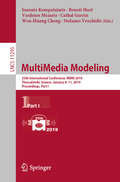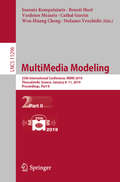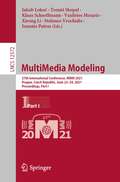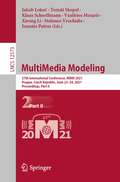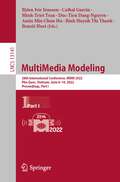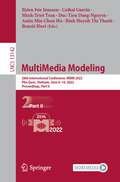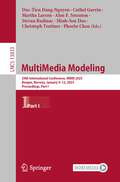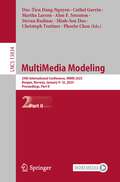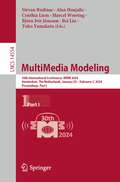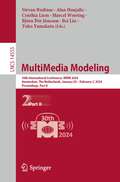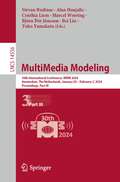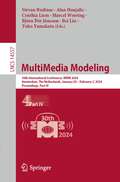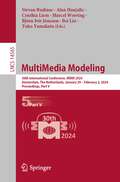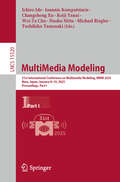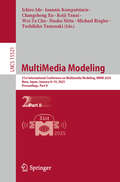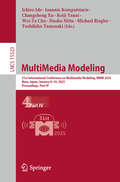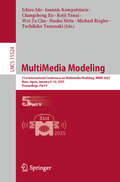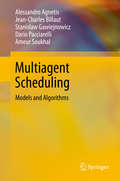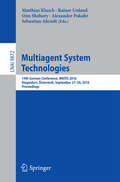- Table View
- List View
MultiMedia Modeling: 25th International Conference, MMM 2019, Thessaloniki, Greece, January 8–11, 2019, Proceedings, Part I (Lecture Notes in Computer Science #11295)
by Benoit Huet Stefanos Vrochidis Cathal Gurrin Ioannis Kompatsiaris Vasileios Mezaris Wen-Huang ChengThe two-volume set LNCS 11295 and 11296 constitutes the thoroughly refereed proceedings of the 25th International Conference on MultiMedia Modeling, MMM 2019, held in Thessaloniki, Greece, in January 2019.Of the 172 submitted full papers, 49 were selected for oral presentation and 47 for poster presentation; in addition, 6 demonstration papers, 5 industry papers, 6 workshop papers, and 6 papers for the Video Browser Showdown 2019 were accepted. All papers presented were carefully reviewed and selected from 204 submissions.
MultiMedia Modeling: 25th International Conference, MMM 2019, Thessaloniki, Greece, January 8–11, 2019, Proceedings, Part II (Lecture Notes in Computer Science #11296)
by Benoit Huet Stefanos Vrochidis Cathal Gurrin Ioannis Kompatsiaris Vasileios Mezaris Wen-Huang ChengThe two-volume set LNCS 11295 and 11296 constitutes the thoroughly refereed proceedings of the 25th International Conference on MultiMedia Modeling, MMM 2019, held in Thessaloniki, Greece, in January 2019. Of the 172 submitted full papers, 49 were selected for oral presentation and 47 for poster presentation; in addition, 6 demonstration papers, 5 industry papers, 6 workshop papers, and 6 papers for the Video Browser Showdown 2019 were accepted. All papers presented were carefully reviewed and selected from 204 submissions.
MultiMedia Modeling: 26th International Conference, MMM 2020, Daejeon, South Korea, January 5–8, 2020, Proceedings, Part I (Lecture Notes in Computer Science #11961)
by Jung-Woo Choi Junmo Kim Wen-Huang Cheng Wei-Ta Chu Peng Cui Min-Chun Hu Wesley De NeveThe two-volume set LNCS 11961 and 11962 constitutes the thoroughly refereed proceedings of the 25th International Conference on MultiMedia Modeling, MMM 2020, held in Daejeon, South Korea, in January 2020. Of the 171 submitted full research papers, 40 papers were selected for oral presentation and 46 for poster presentation; 28 special session papers were selected for oral presentation and 8 for poster presentation; in addition, 9 demonstration papers and 6 papers for the Video Browser Showdown 2020 were accepted. The papers of LNCS 11961 are organized in the following topical sections: audio and signal processing; coding and HVS; color processing and art; detection and classification; face; image processing; learning and knowledge representation; video processing; poster papers; the papers of LNCS 11962 are organized in the following topical sections: poster papers; AI-powered 3D vision; multimedia analytics: perspectives, tools and applications; multimedia datasets for repeatable experimentation; multi-modal affective computing of large-scale multimedia data; multimedia and multimodal analytics in the medical domain and pervasive environments; intelligent multimedia security; demo papers; and VBS papers.
MultiMedia Modeling: 26th International Conference, MMM 2020, Daejeon, South Korea, January 5–8, 2020, Proceedings, Part II (Lecture Notes in Computer Science #11962)
by Jung-Woo Choi Junmo Kim Wen-Huang Cheng Wei-Ta Chu Peng Cui Min-Chun Hu Wesley De NeveThe two-volume set LNCS 11961 and 11962 constitutes the thoroughly refereed proceedings of the 25th International Conference on MultiMedia Modeling, MMM 2020, held in Daejeon, South Korea, in January 2020. Of the 171 submitted full research papers, 40 papers were selected for oral presentation and 46 for poster presentation; 28 special session papers were selected for oral presentation and 8 for poster presentation; in addition, 9 demonstration papers and 6 papers for the Video Browser Showdown 2020 were accepted. The papers of LNCS 11961 are organized in the following topical sections: audio and signal processing; coding and HVS; color processing and art; detection and classification; face; image processing; learning and knowledge representation; video processing; poster papers; the papers of LNCS 11962 are organized in the following topical sections: poster papers; AI-powered 3D vision; multimedia analytics: perspectives, tools and applications; multimedia datasets for repeatable experimentation; multi-modal affective computing of large-scale multimedia data; multimedia and multimodal analytics in the medical domain and pervasive environments; intelligent multimedia security; demo papers; and VBS papers.
MultiMedia Modeling: 27th International Conference, MMM 2021, Prague, Czech Republic, June 22–24, 2021, Proceedings, Part I (Lecture Notes in Computer Science #12572)
by Stefanos Vrochidis Klaus Schoeffmann Vasileios Mezaris Jakub Lokoč Tomáš Skopal Xirong Li Ioannis PatrasThe two-volume set LNCS 12572 and 1273 constitutes the thoroughly refereed proceedings of the 27th International Conference on MultiMedia Modeling, MMM 2021, held in Prague, Czech Republic, in June2021. Of the 211 submitted regular papers, 40 papers were selected for oral presentation and 33 for poster presentation; 16 special session papers were accepted as well as 2 papers for a demo presentation and 17 papers for participation at the Video Browser Showdown 2021. The papers cover topics such as: multimedia indexing; multimedia mining; multimedia abstraction and summarization; multimedia annotation, tagging and recommendation; multimodal analysis for retrieval applications; semantic analysis of multimedia and contextual data; multimedia fusion methods; multimedia hyperlinking; media content browsing and retrieval tools; media representation and algorithms; audio, image, video processing, coding and compression; multimedia sensors and interaction modes; multimedia privacy, security and content protection; multimedia standards and related issues; advances in multimedia networking and streaming; multimedia databases, content delivery and transport; wireless and mobile multimedia networking; multi-camera and multi-view systems; augmented and virtual reality, virtual environments; real-time and interactive multimedia applications; mobile multimedia applications; multimedia web applications; multimedia authoring and personalization; interactive multimedia and interfaces; sensor networks; social and educational multimedia applications; and emerging trends.
MultiMedia Modeling: 27th International Conference, MMM 2021, Prague, Czech Republic, June 22–24, 2021, Proceedings, Part II (Lecture Notes in Computer Science #12573)
by Stefanos Vrochidis Klaus Schoeffmann Vasileios Mezaris Jakub Lokoč Tomáš Skopal Xirong Li Ioannis PatrasThe two-volume set LNCS 12572 and 1273 constitutes the thoroughly refereed proceedings of the 27th International Conference on MultiMedia Modeling, MMM 2021, held in Prague, Czech Republic, in June2021. Of the 211 submitted regular papers, 40 papers were selected for oral presentation and 33 for poster presentation; 16 special session papers were accepted as well as 2 papers for a demo presentation and 17 papers for participation at the Video Browser Showdown 2021. The papers cover topics such as: multimedia indexing; multimedia mining; multimedia abstraction and summarization; multimedia annotation, tagging and recommendation; multimodal analysis for retrieval applications; semantic analysis of multimedia and contextual data; multimedia fusion methods; multimedia hyperlinking; media content browsing and retrieval tools; media representation and algorithms; audio, image, video processing, coding and compression; multimedia sensors and interaction modes; multimedia privacy, security and content protection; multimedia standards and related issues; advances in multimedia networking and streaming; multimedia databases, content delivery and transport; wireless and mobile multimedia networking; multi-camera and multi-view systems; augmented and virtual reality, virtual environments; real-time and interactive multimedia applications; mobile multimedia applications; multimedia web applications; multimedia authoring and personalization; interactive multimedia and interfaces; sensor networks; social and educational multimedia applications; and emerging trends.
MultiMedia Modeling: 28th International Conference, MMM 2022, Phu Quoc, Vietnam, June 6–10, 2022, Proceedings, Part I (Lecture Notes in Computer Science #13141)
by Benoit Huet Cathal Gurrin Björn Þór Jónsson Minh-Triet Tran Duc-Tien Dang-Nguyen Anita Min-Chun Hu Binh Huynh Thi ThanhThe two-volume set LNCS 13141 and LNCS 13142 constitutes the proceedings of the 28th International Conference on MultiMedia Modeling, MMM 2022, which took place in Phu Quoc, Vietnam, during June 6–10, 2022.The 107 papers presented in these proceedings were carefully reviewed and selected from a total of 212 submissions. They focus on topics related to multimedia content analysis; multimedia signal processing and communications; and multimedia applications and services.
MultiMedia Modeling: 28th International Conference, MMM 2022, Phu Quoc, Vietnam, June 6–10, 2022, Proceedings, Part II (Lecture Notes in Computer Science #13142)
by Benoit Huet Cathal Gurrin Björn Þór Jónsson Minh-Triet Tran Duc-Tien Dang-Nguyen Anita Min-Chun Hu Binh Huynh Thi ThanhThe two-volume set LNCS 13141 and LNCS 13142 constitutes the proceedings of the 28th International Conference on MultiMedia Modeling, MMM 2022, which took place in Phu Quoc, Vietnam, during June 6–10, 2022.The 107 papers presented in these proceedings were carefully reviewed and selected from a total of 212 submissions. They focus on topics related to multimedia content analysis; multimedia signal processing and communications; and multimedia applications and services.
MultiMedia Modeling: 29th International Conference, MMM 2023, Bergen, Norway, January 9–12, 2023, Proceedings, Part I (Lecture Notes in Computer Science #13833)
by Christoph Trattner Alan F. Smeaton Cathal Gurrin Duc-Tien Dang-Nguyen Phoebe Chen Martha Larson Stevan Rudinac Minh-Son DaoThe two-volume set LNCS 13833 and LNCS 13834 constitutes the proceedings of the 29th International Conference on MultiMedia Modeling, MMM 2023, which took place in Bergen, Norway, during January 9-12, 2023. The 86 papers presented in these proceedings were carefully reviewed and selected from a total of 267 submissions. They focus on topics related to multimedia content analysis; multimedia signal processing and communications; and multimedia applications and services.
MultiMedia Modeling: 29th International Conference, MMM 2023, Bergen, Norway, January 9–12, 2023, Proceedings, Part II (Lecture Notes in Computer Science #13834)
by Christoph Trattner Alan F. Smeaton Cathal Gurrin Duc-Tien Dang-Nguyen Phoebe Chen Martha Larson Stevan Rudinac Minh-Son DaoThe two-volume set LNCS 13833 and LNCS 13834 constitutes the proceedings of the 29th International Conference on MultiMedia Modeling, MMM 2023, which took place in Bergen, Norway, during January 9-12, 2023. The 86 papers presented in these proceedings were carefully reviewed and selected from a total of 267 submissions. They focus on topics related to multimedia content analysis; multimedia signal processing and communications; and multimedia applications and services.
MultiMedia Modeling: 30th International Conference, MMM 2024, Amsterdam, The Netherlands, January 29 – February 2, 2024, Proceedings, Part I (Lecture Notes in Computer Science #14554)
by Marcel Worring Björn Þór Jónsson Alan Hanjalic Stevan Rudinac Cynthia Liem Bei Liu Yoko YamakataThis book constitutes the refereed proceedings of the 30th International Conference on MultiMedia Modeling, MMM 2024, held in Amsterdam, The Netherlands, during January 29 – February 2, 2024.The 112 full papers included in this volume were carefully reviewed and selected from 297 submissions. The MMM conference were organized in topics related to multimedia modelling, particularly: audio, image, video processing, coding and compression; multimodal analysis for retrieval applications, and multimedia fusion methods.
MultiMedia Modeling: 30th International Conference, MMM 2024, Amsterdam, The Netherlands, January 29 – February 2, 2024, Proceedings, Part II (Lecture Notes in Computer Science #14555)
by Marcel Worring Björn Þór Jónsson Alan Hanjalic Stevan Rudinac Cynthia Liem Bei Liu Yoko YamakataThis book constitutes the refereed proceedings of the 30th International Conference on MultiMedia Modeling, MMM 2024, held in Amsterdam, The Netherlands, during January 29–February 2, 2024.The 112 full papers included in this volume were carefully reviewed and selected from 297 submissions. The MMM conference were organized in topics related to multimedia modelling, particularly: audio, image, video processing, coding and compression; multimodal analysis for retrieval applications, and multimedia fusion methods.
MultiMedia Modeling: 30th International Conference, MMM 2024, Amsterdam, The Netherlands, January 29 – February 2, 2024, Proceedings, Part III (Lecture Notes in Computer Science #14556)
by Marcel Worring Björn Þór Jónsson Alan Hanjalic Stevan Rudinac Cynthia Liem Bei Liu Yoko YamakataThis book constitutes the refereed proceedings of the 30th International Conference on MultiMedia Modeling, MMM 2024, held in Amsterdam, The Netherlands, during January 29–February 2, 2024.The 112 full papers included in this volume were carefully reviewed and selected from 297 submissions. The MMM conference were organized in topics related to multimedia modelling, particularly: audio, image, video processing, coding and compression; multimodal analysis for retrieval applications, and multimedia fusion methods.
MultiMedia Modeling: 30th International Conference, MMM 2024, Amsterdam, The Netherlands, January 29 – February 2, 2024, Proceedings, Part IV (Lecture Notes in Computer Science #14557)
by Marcel Worring Björn Þór Jónsson Alan Hanjalic Stevan Rudinac Cynthia Liem Bei Liu Yoko YamakataThis book constitutes the refereed proceedings of the 30th International Conference on MultiMedia Modeling, MMM 2024, held in Amsterdam, The Netherlands, during January 29–February 2, 2024.The 112 full papers included in this volume were carefully reviewed and selected from 297 submissions. The MMM conference were organized in topics related to multimedia modelling, particularly: audio, image, video processing, coding and compression; multimodal analysis for retrieval applications, and multimedia fusion methods.
MultiMedia Modeling: 30th International Conference, MMM 2024, Amsterdam, The Netherlands, January 29 – February 2, 2024, Proceedings, Part V (Lecture Notes in Computer Science #14565)
by Marcel Worring Björn Þór Jónsson Alan Hanjalic Stevan Rudinac Cynthia Liem Bei Liu Yoko YamakataThis book constitutes the refereed proceedings of the 30th International Conference on MultiMedia Modeling, MMM 2024, held in Amsterdam, The Netherlands, during January 29–February 2, 2024.The 120 full papers included in this volume were carefully reviewed and selected from 297 submissions. The MMM conference were organized in topics related to multimedia modelling, particularly: audio, image, video processing, coding and compression; multimodal analysis for retrieval applications, and multimedia fusion methods.
MultiMedia Modeling: 31st International Conference on Multimedia Modeling, MMM 2025, Nara, Japan, January 8–10, 2025, Proceedings, Part I (Lecture Notes in Computer Science #15520)
by Changsheng Xu Ioannis Kompatsiaris Toshihiko Yamasaki Wei-Ta Chu Ichiro Ide Keiji Yanai Naoko Nitta Michael RieglerThis five-volume set LNCS 15520-15524 constitutes the proceedings of the 31st International Conference on Multimedia Modeling, MMM 2025, held in Nara, Japan, January 8–10, 2025. The 135 full papers and 41 short papers presented in these proceedings were carefully reviewed and selected from 348 submissions. The MMM conference was organized in topics related to multimedia modelling, particularly: audio, image, video processing, coding and compression; multimodal analysis for retrieval applications, and multimedia fusion methods.
MultiMedia Modeling: 31st International Conference on Multimedia Modeling, MMM 2025, Nara, Japan, January 8–10, 2025, Proceedings, Part II (Lecture Notes in Computer Science #15521)
by Changsheng Xu Ioannis Kompatsiaris Toshihiko Yamasaki Wei-Ta Chu Ichiro Ide Keiji Yanai Naoko Nitta Michael RieglerThis five-volume set LNCS 15520-15524 constitutes the proceedings of the 31st International Conference on Multimedia Modeling, MMM 2025, held in Nara, Japan, January 8–10, 2025. The 135 full papers and 41 short papers presented in these proceedings were carefully reviewed and selected from 348 submissions. The MMM conference was organized in topics related to multimedia modelling, particularly: audio, image, video processing, coding and compression; multimodal analysis for retrieval applications, and multimedia fusion methods.
MultiMedia Modeling: 31st International Conference on Multimedia Modeling, MMM 2025, Nara, Japan, January 8–10, 2025, Proceedings, Part III (Lecture Notes in Computer Science #15522)
by Changsheng Xu Ioannis Kompatsiaris Toshihiko Yamasaki Wei-Ta Chu Ichiro Ide Keiji Yanai Naoko Nitta Michael RieglerThis five-volume set LNCS 15520-15524 constitutes the proceedings of the 31st International Conference on Multimedia Modeling, MMM 2025, held in Nara, Japan, January 8–10, 2025. The 135 full papers and 41 short papers presented in these proceedings were carefully reviewed and selected from 348 submissions. The MMM conference was organized in topics related to multimedia modelling, particularly: audio, image, video processing, coding and compression; multimodal analysis for retrieval applications, and multimedia fusion methods.
MultiMedia Modeling: 31st International Conference on Multimedia Modeling, MMM 2025, Nara, Japan, January 8–10, 2025, Proceedings, Part IV (Lecture Notes in Computer Science #15523)
by Changsheng Xu Ioannis Kompatsiaris Toshihiko Yamasaki Wei-Ta Chu Ichiro Ide Keiji Yanai Naoko Nitta Michael RieglerThis five-volume set LNCS 15520-15524 constitutes the proceedings of the 31st International Conference on Multimedia Modeling, MMM 2025, held in Nara, Japan, January 8–10, 2025. The 135 full papers and 41 short papers presented in these proceedings were carefully reviewed and selected from 348 submissions. The MMM conference was organized in topics related to multimedia modelling, particularly: audio, image, video processing, coding and compression; multimodal analysis for retrieval applications, and multimedia fusion methods.
MultiMedia Modeling: 31st International Conference on Multimedia Modeling, MMM 2025, Nara, Japan, January 8–10, 2025, Proceedings, Part V (Lecture Notes in Computer Science #15524)
by Changsheng Xu Ioannis Kompatsiaris Toshihiko Yamasaki Wei-Ta Chu Ichiro Ide Keiji Yanai Naoko Nitta Michael RieglerThis five-volume set LNCS 15520-15524 constitutes the proceedings of the 31st International Conference on Multimedia Modeling, MMM 2025, held in Nara, Japan, January 8–10, 2025. The 135 full papers and 41 short papers presented in these proceedings were carefully reviewed and selected from 348 submissions. The MMM conference was organized in topics related to multimedia modelling, particularly: audio, image, video processing, coding and compression; multimodal analysis for retrieval applications, and multimedia fusion methods.
Multiagent Scheduling
by Jean-Charles Billaut Alessandro Agnetis Stanisław Gawiejnowicz Dario Pacciarelli Ameur SoukhalScheduling theory has received a growing interest since its origins in the second half of the 20th century. Developed initially for the study of scheduling problems with a single objective, the theory has been recently extended to problems involving multiple criteria. However, this extension has still left a gap between the classical multi-criteria approaches and some real-life problems in which not all jobs contribute to the evaluation of each criterion. In this book, we close this gap by presenting and developing multi-agent scheduling models in which subsets of jobs sharing the same resources are evaluated by different criteria. Several scenarios are introduced, depending on the definition and the intersection structure of the job subsets. Complexity results, approximation schemes, heuristics and exact algorithms are discussed for single-machine and parallel-machine scheduling environments. Definitions and algorithms are illustrated with the help of examples and figures.
Multiagent System Technologies
by Onn Shehory Rainer Unland Matthias Klusch Alexander Pokahr Sebastian AhrndtAfter the huge success of the ?rst German Conference on Multiagent System Technologies (MATES) last year in Erfurt the German Special Interest Group on Distributed Arti'cial Intelligence together with the steering committee of MATES proudly organized and conducted this international conference for the second time. ThegoaloftheMATESconferenceistoconstituteahigh-qualityplatformfor thepresentationanddiscussionofnewresearchresultsandsystemdevelopments. It provides an interdisciplinary forum for researchers, users, and developers, to present and discuss the latest advances in research work, as well as prototyped or'eldedsystemsofintelligentagents. Theconferencecoversthecompleterange from theory to application of agent and multiagent technologies. MATES 2004 was conducted - asanintegralpartofthe5thInternationalConferenceNet. ObjectDays2004 along with the - 8th International Workshop on Cooperative Information Agents (CIA) 2004 - Autumn meeting of FIPA (Foundation for Intelligent Physical Agents) - PrototypeandProductExhibitionofAgentRelatedPlatforms, Frameworks, Systems, Applications, and Tools As such all these events together may have formed the biggest agent-related event of this year in Europe and one of the biggest worldwide. The call-for-papers attracted about 60 submissions from all over the world. After a carefulreviewing process, the internationalprogramcommittee accepted 22 high-quality papers of particular relevance and quality. The selected cont- butions cover a wide range of exciting topics, in particular agent analysis and security, agent negotiation and control, agents and software engineering, s- ulation and agents, and agent policies and testing. Exciting highlights of the conference were the invited talks, by Jim Odell on Agent UML 2. 0: Too Radical or Not Radical Enough?, and Cristiano Castelfranchi on Emergence and C- nition: Towards a Synthetic Paradigm in AI and Cognitive Science. Moreover, several agent-related tutorials were conducted.
Multiagent System Technologies
by Jörg P. Müller Wolf Ketter Gal Kaminka Gerd Wagner Nils BullingThis book constitutes the proceedings of the 13th German Conference on Multiagent System Technologies, MATES 2015, held in Cottbus, Germany, in September 2015. The 11 full papers papers presented together with 2 short papers, 1 invited paper and 4 extended abstracts of doctoral papers in this volume were carefully reviewed and selected from 27 submissions. The papers are organized in topical sections on MAS engineering, modeling, and simulation; smart things working together; and innovative and emerging applications of MAS.
Multiagent System Technologies
by Paolo Petta Rainer Unland Jan Ole BerndtAfter the huge success of the ?rst German Conference on Multiagent System Technologies (MATES) last year in Erfurt the German Special Interest Group on Distributed Arti'cial Intelligence together with the steering committee of MATES proudly organized and conducted this international conference for the second time. ThegoaloftheMATESconferenceistoconstituteahigh-qualityplatformfor thepresentationanddiscussionofnewresearchresultsandsystemdevelopments. It provides an interdisciplinary forum for researchers, users, and developers, to present and discuss the latest advances in research work, as well as prototyped or'eldedsystemsofintelligentagents. Theconferencecoversthecompleterange from theory to application of agent and multiagent technologies. MATES 2004 was conducted - asanintegralpartofthe5thInternationalConferenceNet. ObjectDays2004 along with the - 8th International Workshop on Cooperative Information Agents (CIA) 2004 - Autumn meeting of FIPA (Foundation for Intelligent Physical Agents) - PrototypeandProductExhibitionofAgentRelatedPlatforms, Frameworks, Systems, Applications, and Tools As such all these events together may have formed the biggest agent-related event of this year in Europe and one of the biggest worldwide. The call-for-papers attracted about 60 submissions from all over the world. After a carefulreviewing process, the internationalprogramcommittee accepted 22 high-quality papers of particular relevance and quality. The selected cont- butions cover a wide range of exciting topics, in particular agent analysis and security, agent negotiation and control, agents and software engineering, s- ulation and agents, and agent policies and testing. Exciting highlights of the conference were the invited talks, by Jim Odell on Agent UML 2. 0: Too Radical or Not Radical Enough?, and Cristiano Castelfranchi on Emergence and C- nition: Towards a Synthetic Paradigm in AI and Cognitive Science. Moreover, several agent-related tutorials were conducted.
Multiagent Systems
by Yoav Shoham Kevin Leyton-BrownMultiagent systems combine multiple autonomous entities, each having diverging interests or different information. This overview of the field offers a computer science perspective, but also draws on ideas from game theory, economics, operations research, logic, philosophy and linguistics. It will serve as a reference for researchers in each of these fields, and be used as a text for advanced undergraduate or graduate courses. The authors emphasize foundations to create a broad and rigorous treatment of their subject, with thorough presentations of distributed problem solving, game theory, multiagent communication and learning, social choice, mechanism design, auctions, cooperative game theory, and modal logics of knowledge and belief. For each topic, basic concepts are introduced, examples are given, proofs of key results are offered, and algorithmic considerations are examined. An appendix covers background material in probability theory, classical logic, Markov decision processes and mathematical programming.
